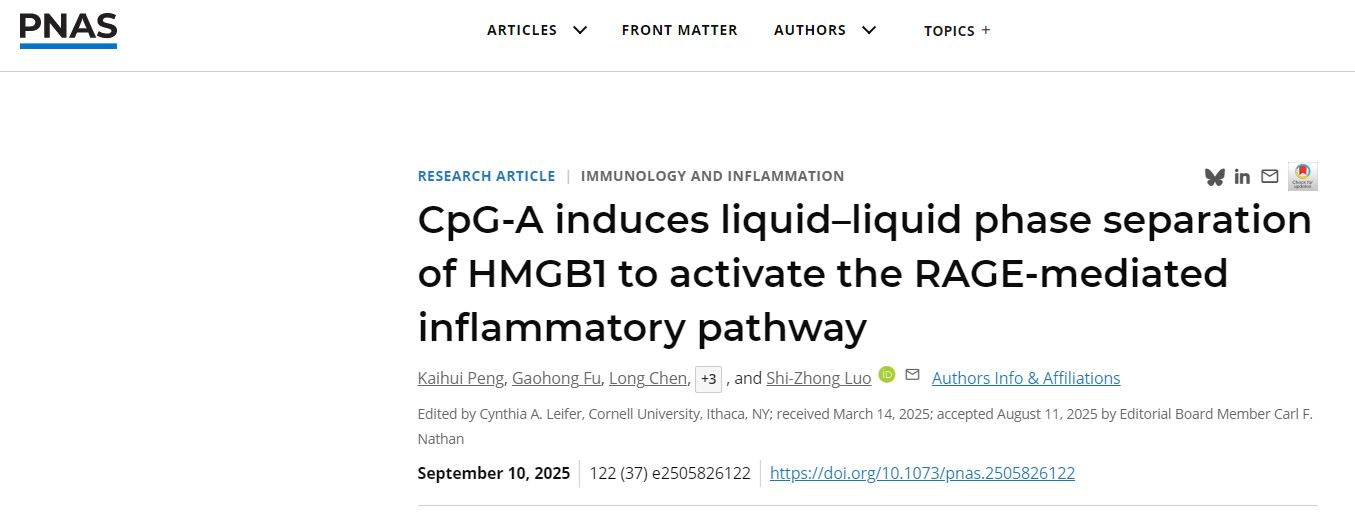Pathogen-associated molecular patterns (PAMPs) and damage-associated molecular patterns (DAMPs) are key factors triggering immune inflammatory responses. Among these, unmethylated CpG sequences in bacterial DNA serve as typical PAMPs commonly found in plasma during infection, yet their molecular mechanisms for activating immune receptors remain incompletely understood.

On September 10, 2025, Professor Luo Shizhong's research group at our university published a study titled “CpG-A induces liquid–liquid phase separation of HMGB1 to activate the RAGE-mediated inflammatory pathway” in the Proceedings of the National Academy of Sciences of the United States of America. The study proposes a novel mechanism: Extracellular molecular phase separation can drive intracellular signaling molecule phase separation, enabling rapid and efficient transmembrane transduction of immune signals.

Figure 1. Model of double-stranded DNA-induced HMGB1 phase separation activating the RAGE-mediated inflammatory signaling pathway in macrophages
The study reveals that the bacterial DNA analog CpG-A forms liquid–liquid phase separation (LLPS) aggregates with the danger signal molecule HMGB1 in the extracellular space. These aggregates bind to the glycated end-product receptor RAGE, inducing its cytoplasmic domain to form a complex with the downstream signaling protein SLP76. This activates the MAPK signaling pathway and promotes the release of inflammatory cytokines (Figure 1). Furthermore, endotoxin LPS acts as a synergistic ligand to enhance the phase separation potential of the HMGB1-RAGE complex. SLP76 droplets further enrich key signaling factors such as Grb2 and Sos1, forming functional signaling platforms that accelerate inflammatory signaling cascades.
In summary, this discovery not only deepens our understanding of HMGB1's role in infection and inflammation but also provides a novel molecular mechanism explaining how pathogen DNA triggers immune responses. It simultaneously opens new avenues for intervention strategies targeting related inflammatory diseases. Professor Luo Shizhong from the State Key Laboratory of Green Biomanufacturing, School of Life Sciences and Technology, Beijing University of Chemical Technology, and Professor Li Jinping from the Center for Soft Matter and Advanced Materials, Beijing University of Chemical Technology, are the corresponding authors. Doctoral student Peng Kaihui is the first author, with Beijing University of Chemical Technology as the primary contributing institution.
Author Profile:
Luo Shizhong, Professor at Beijing University of Chemical Technology and doctoral supervisor, is a nationally recognized high-level talent and Chief Scientist of a National Key R&D Program project. He earned his bachelor's and doctoral degrees from the Department of Chemistry at Tsinghua University, where he received the Tsinghua University Outstanding Doctoral Dissertation Award. He subsequently conducted postdoctoral research at the University of Texas. Joined the School of Life Sciences at Beijing University of Chemical Technology in 2008 as a high-level introduced talent. His research focuses on the biosynthesis and bioactivity characterization of pharmaceutical peptides, as well as the fundamental theories and technological innovations related to the molecular mechanisms and functions of protein phase transitions and aggregation. He has published over 50 SCI papers as corresponding author in prestigious journals including PNAS, Nature Communications, and Science Advances. He serves as a member of the Academic Committee at Beijing University of Chemical Technology, a visiting professor at Tarim University, an expert committee member of the Peptide Branch of the China Association for Biochemical and Pharmaceutical Sciences, and an editorial board member of Supramolecular Materials. His honors include the Third Prize of Beijing Science and Technology Award, Beijing Science and Technology Rising Star, Beijing Course-based Ideological and Political Education Teaching Master, and the Young Peptide Scientist Award at the China International Peptide Conference.
